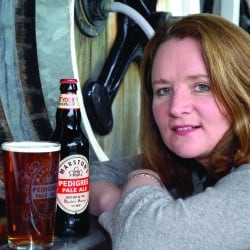He made the sign of the cross, adjusted his mitre and in a deep baritone voice welcomed us to “the cathedral”. The rest of the party looked puzzled and I had to explain the sacrilegious joke to them over a glass of Pedigree in the visitor centre in Burton-on-Trent, Staffordshire.
I don’t know whether His Grace the Mythical Bishop of Burton will be appearing again this month but there are celebrations taking place that deserve divine recognition. Marston’s Pedigree is 60 years old and the brewery is marking the occasion by producing a “retro” bottle and label from the time of the beer’s first appearance in 1952.
That’s fine, but the emphasis should really be on the draught version of Pedigree. It’s labelled as bitter but in truth it’s a classic Burton pale ale. It’s not only one of the biggest-selling premium cask beers in the country but it’s been around for far longer than 1952.
The brewery called Marston’s today dates from 1905 when three Burton brewers merged to form Marston, Thompson & Evershed.
Before the arrival of Evershed, Marston & Thompson had moved in 1898 into the Albion Brewery in Burton that had been built by the major London brewer Mann Crossman & Paulin.
The brewer had gone to Burton at the height of the craze for Burton pale ale in the 19th century. When scientists taught brewers how to “Burtonise” their brewing water, it returned to London. But its name lives on, carved in the brickwork of the main building at Marston’s.
In the fashion of the time, Marston’s pale ales were called after the simple branding on the casks: P, PX, PXX and PXXX.
In 1952, Marston’s head brewer George Peard decided that P was a poor name for his biggest-selling pale ale. Calling for “a pint of P” may have been acceptable in Victorian times but it was less than desirable in the more vulgar Fifties.
Peard decided to stage a competition among Marston’s workforce for a better name for the beer. Marjorie Newbold in the typing pool came up with Pedigree and a legend was born.

All the famous names of Burton brewing are long gone: Bass, Ind Coope and Worthington. There is now a clutch of excellent small craft brewers in the town, but Marston’s remains the sole survivor from the dizzy days of the 1800s, when Burton was the most important brewing centre in the world.
Burton built its position on the quality of the water from springs in the Trent Valley. Water or “brewing liquor” is critical to the flavour of beer and Burton has it in abundance. Marston’s alone draws more than one million gallons of water a week from wells in the Horninglow district of the town.
In the 1860s a remarkable eccentric called William Molyneux wrote a book about Burton, its brewers and its water. He unravelled the nature of the local water by walking around the Trent Valley and jabbing pipes deep into the soil. He discovered that the soil and rocks of the area were made up of gravel, marl, sandstone and clay, with rich deposits of gypsum and magnesium. It’s gypsum and magnesium — sulphates — that draw out the finest flavours from malts and hops, and help give Burton beers their distinctive bitterness and renowned sulphury aroma.
Burton ales and water achieved cult status in Victorian times thanks to the invention of the ‘union set’ method of fermentation.
It was created in 1838 by Peter Walker, a Liverpool brewer, who came to Burton to brew pale ale and responded to consumer demand for beer free of yeasty dregs.
The unions are sets of large oak casks, each one holding 150 gallons of beer. They are linked — “held in union” to use the Victorian phrase — by pipes and troughs. As beer ferments in the casks, it’s driven by natural carbon dioxide up pipes into troughs set above them. The troughs are set at an angle, allowing the beer to run back into the casks but retaining most of the yeast. Sufficient yeast remains in the beer to allow a natural further fermentation in cask when the beer reaches pub cellars.
Thanks to the water and the unions, Marston’s Pedigree remains a classic Burton pale ale.
I don’t know if the bishop will bless the beer on its 60th birthday but he should certainly say a prayer for Marjorie Newbold.
